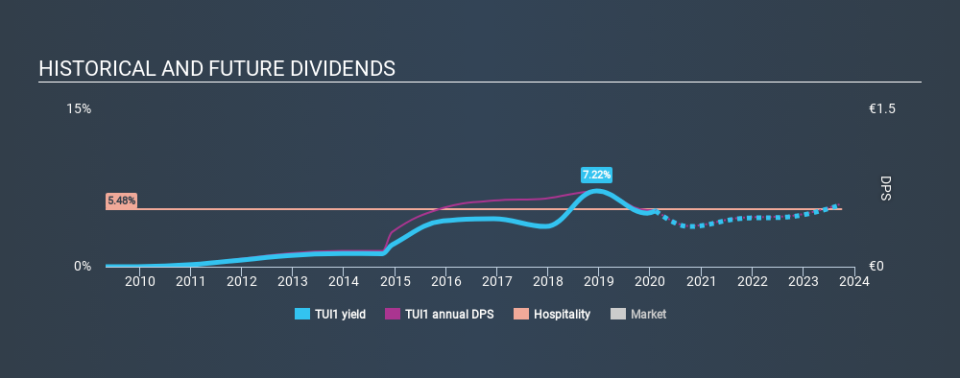2 Days To Buy TUI AG (ETR:TUI1) Before The Ex-Dividend Date

TUI AG (ETR:TUI1) is about to trade ex-dividend in the next 2 days. This means that investors who purchase shares on or after the 12th of February will not receive the dividend, which will be paid on the 14th of February.
TUI's next dividend payment will be €0.54 per share, on the back of last year when the company paid a total of €0.54 to shareholders. Looking at the last 12 months of distributions, TUI has a trailing yield of approximately 5.3% on its current stock price of €10.15. Dividends are an important source of income to many shareholders, but the health of the business is crucial to maintaining those dividends. We need to see whether the dividend is covered by earnings and if it's growing.
View our latest analysis for TUI
Dividends are typically paid from company earnings. If a company pays more in dividends than it earned in profit, then the dividend could be unsustainable. It paid out 76% of its earnings as dividends last year, which is not unreasonable, but limits reinvestment in the business and leaves the dividend vulnerable to a business downturn. It could become a concern if earnings started to decline. That said, even highly profitable companies sometimes might not generate enough cash to pay the dividend, which is why we should always check if the dividend is covered by cash flow. It paid out an unsustainably high 331% of its free cash flow as dividends over the past 12 months, which is worrying. Unless there were something in the business we're not grasping, this could signal a risk that the dividend may have to be cut in the future.
While TUI's dividends were covered by the company's reported profits, cash is somewhat more important, so it's not great to see that the company didn't generate enough cash to pay its dividend. Cash is king, as they say, and were TUI to repeatedly pay dividends that aren't well covered by cashflow, we would consider this a warning sign.
Click here to see the company's payout ratio, plus analyst estimates of its future dividends.
Have Earnings And Dividends Been Growing?
Businesses with strong growth prospects usually make the best dividend payers, because it's easier to grow dividends when earnings per share are improving. Investors love dividends, so if earnings fall and the dividend is reduced, expect a stock to be sold off heavily at the same time. Fortunately for readers, TUI's earnings per share have been growing at 18% a year for the past five years. Earnings have been growing at a decent rate, but we're concerned dividend payments consumed most of the company's cash flow over the past year.
The main way most investors will assess a company's dividend prospects is by checking the historical rate of dividend growth. TUI has delivered an average of 24% per year annual increase in its dividend, based on the past six years of dividend payments. It's great to see earnings per share growing rapidly over several years, and dividends per share growing right along with it.
Final Takeaway
From a dividend perspective, should investors buy or avoid TUI? Earnings per share growth is a positive, and the company's payout ratio looks normal. However, we note TUI paid out a much higher percentage of its free cash flow, which makes us uncomfortable. While it does have some good things going for it, we're a bit ambivalent and it would take more to convince us of TUI's dividend merits.
Wondering what the future holds for TUI? See what the 17 analysts we track are forecasting, with this visualisation of its historical and future estimated earnings and cash flow
We wouldn't recommend just buying the first dividend stock you see, though. Here's a list of interesting dividend stocks with a greater than 2% yield and an upcoming dividend.
If you spot an error that warrants correction, please contact the editor at editorial-team@simplywallst.com. This article by Simply Wall St is general in nature. It does not constitute a recommendation to buy or sell any stock, and does not take account of your objectives, or your financial situation. Simply Wall St has no position in the stocks mentioned.
We aim to bring you long-term focused research analysis driven by fundamental data. Note that our analysis may not factor in the latest price-sensitive company announcements or qualitative material. Thank you for reading.

 Yahoo Finance
Yahoo Finance 
